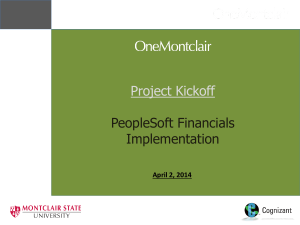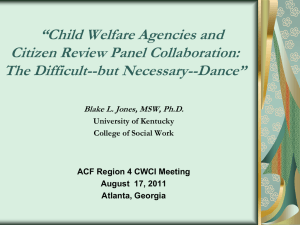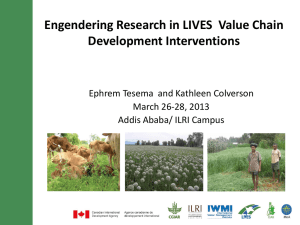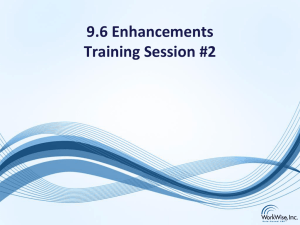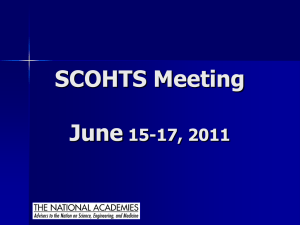Dryland Systems CRP update
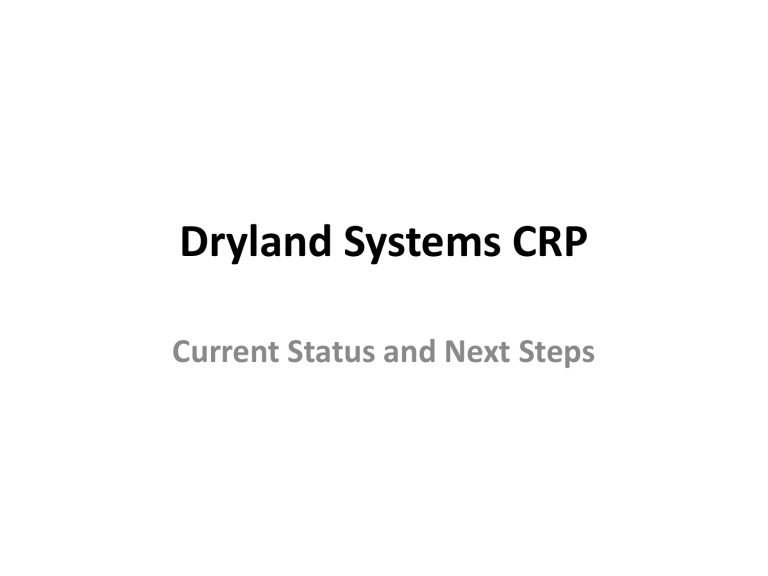
Dryland Systems CRP
Current Status and Next Steps
Outline
•
Current status and challenges
• Launch Meeting
• IDOs
• Second CRP Phase
• June donor/stakeholder meeting in
Montpellier
• ESA work plans
Drylands CRP Accepted
•
A number of ISPC criticisms remain
–
Lack of a Program-level logframe
•
Will end on Dec 31 2014!
•
2012 Annual report (past) due
–
Inception phase not implementation
–
Thematic or maybe regional emphasis (not center)
–
Resolving PPA format with new format
–
CO does not have to accept or forward to CB or FO
Outline
• Current status and challenges
•
Launch Meeting
• IDOs
• Second CRP Phase
• June donor/stakeholder meeting in
Montpellier
• ESA work plans
Launch Meeting May 21-23 Amman Jordan
Agenda being prepared for circulation
Steering Committee Meeting
Independent Science Advisors Meeting
Program-level logframe and IDOs
Harmonization across regions
Governance/Management
Research Support and Performance Management
Geoinformatics
Models
M&E/Impact Pathway
Innovation Systems
Communication
Gender
Youth
Capacity Building
Breakout Groups for Workplans (By Theme? Region? Activity?)
Workplans, logframes, etc. must facilitate Reporting
Outline
• Current status and challenges
• Launch Meeting
•
IDOs
• Second CRP Phase
• June donor/stakeholder meeting in
Montpellier
• ESA work plans
CRPIDOs and SLIDOs
• There are now “system level IDOs” and therefore the new acronym
“SLIDOs”, as well CRP IDOs.
• The CRP IDOs are intended to cluster to the SL IDOs, which in turn lead to the “system level outcomes” (SLOs).
• The three system CRPS (Dryland Systems, Humid Tropic Systems, and
Aquatic Agriculture Systems) met with a view towards
– 1) harmonizing their IDOs,
– 2) achieving a common or coherent narrative that defined and clarified the roles and missions as distinct from the commodity and natural resource CRPs, and
– 3) come up with a common “SL IDO.”
• For the moment, the SLIDO for the systems CRPs is “Capacity to
Innovate”.
• IDOs will play a very important role in 2 nd CRP phase
• Guidelines on their development are available
• Final IDOs scheduled for September
Generic IDOs for Dryland Systems CRP:
(associated with four Strategic Research Themes (SRTs))
SRT1. Approaches to strengthening innovation systems, building stakeholder innovation capacity, and linking knowledge to policy action.
Effective innovation systems identified and applied to the adoption of interventions or policies
Enhanced capacity for innovation in trans-disciplinary research-for-development (R4D) processes
Effective Linkages of research to policy action in a dryland context
SRT2. Reducing vulnerability and managing risk.
Combinations of institutional, biophysical, market, and management options for reducing vulnerability and increasing resilience designed and developed
Trade-offs among options for reducing vulnerability and mitigating risk analyzed within regions
Knowledge-based systems developed for customizing options to sites and circumstances
SRT3. Sustainable intensification for more productive, profitable and diversified dryland agriculture with wellestablished linkages to markets.
Sustainable intensification options designed and developed, including the development and servicing of profitable niche markets
Trade-offs among profitability and risk of sustainable intensification and diversification options analyzed within regions.
Knowledge-based systems developed for customizing options to sites and circumstances
SRT4. Anticipating and measuring impacts and cross-regional synthesis.
Livelihood and ecosystem characterization and monitoring
Across-region synthesis of lessons learned from SRTs 1, 2, and 3
Impact measured
Outline
• Current status and challenges
• Launch Meeting
• IDOs
•
Second CRP Phase
• June donor/stakeholder meeting in
Montpellier
• ESA work plans
What’s wrong with the current round of CRPs
1.
Programs were designed “in the rearview mirror” – putting together existing work of participating centers, sometimes lacking a strong internal logic – rather than answering the question: what program design would have the greatest impact on the problem to be solved and how can value for money be maximized.
2.
Programs were designed in a stand alone fashion, without considering the value addition of each CRP to the system level portfolio-thereby raising questions about overlaps, missed synergies and lower impact/value for money of the entire portfolio
3.
Milestones, outputs, and outcomes of the programs are long lists of items that may be of value for internal project management – but do not provide relevant information on progress for investors / donors. Even strong CRPs do not have an agreed way to show their performance in a satisfactory manner.
4.
There is no clarity on the specific usage of W1-2 funds (in part because there is only weak linkage between actual activities and the original proposal – and the CRPs were initially not asked to provide) making it hard to report and demonstrate value for money.
5.
There is lack of clarity on the role of bilateral projects in the CRPs – even CRP leaders in some programs have no overview what the bilateral projects do, or how they contribute to CRPs, if they do.
6.
W1-2 and W3-bilateral funding streams are interlinked (in the sense that they leverage each other – with W1-
2 funding a larger than proportional share of CGIAR staff; and W3-bilateral funding a larger than proportional share of partners) – but there is no clarity at the Consortium, Fund or donor level how this is done – and whether such leveraging is in fact good or bad.
7.
There is no agreement among donors on harmonized reporting leading to multiple reporting requests – in part caused (or not helped) by the fact that there is not a strong monitoring system of relevant outcome indicators proposed by the programs (yet).
8.
There is no system of priorities that helps assess relative contributions to system level outcomes across the
CRP portfolio, or helps allocate resources across programs.
Process for CGIAR Research Program 2nd call for proposals (2015-2017)
1. Substantive guidance CRPs will be asked to develop proposals to meet the
IDOs developed in 2013, along with other guidance
2. Harmonize / synchronize end dates of all current phase 1 CRP contracts
(except the Genebank CRP) to 31/12/2014
3. Call for Concept Notes (10 page max) by invitation only, i.e. only the existing
CRPs plus additional ones by invitation
4. Review and recommended guidance
5. Approval for call for full proposals
6. Proposal development
7. Independent External Review
8. Approval of stage 2 CRP portfolio of “big project” CNs by CB and FC
9. CRP leadership develops full proposals for approved big project CNs and seeks funding from W3 / bilateral donors.
10. CPA and PIA for CRP and projects.
11. Project outcomes and performance
12. Annual program (CRP) performance appraisal
13. Overall program (CRP) performance is externally reviewed every three years
Outline
• Current status and challenges
• Launch Meeting
• IDOs
•
Second CRP Phase
• June donor/stakeholder meeting in
Montpellier
• ESA work plans
CRP Engagement with Donors and External
Stakeholders to Discuss Targets, Theory of Change,
Impact Pathways and Indicators for Definition and
Prioritization of CRP-level IDOs
Montpellier France
June 17-28, 2013
Day 1
Plenary Session
8:30 - 10:30
10:30 – 11:00
11:00 – 12:30
12:30 – 14:00
14:00 – 17:00
19:00 – 21:00
CRPs Presentations (10 min) Followed by Discussions (20 min)
- Focus Areas
- Cross Cutting IDOs
- Regional Collaborations
- Partnerships
Coffee Break
Donors & Stakeholder Presentations & Feedback Followed by Discussion
- Donor Investment Priorities
- Partnerships, Boundary Work and Impact Pathways
Lunch
CRP-1 Presentation (30 min) (closed session of CRP1 with its investors, partners and stakeholders)
- IDOs, ToC, Impact Pathways
- Time-Phased 10 year Work Plan
- Estimated Budget
Discussion
Group Dinner
Engagement with Donors and External Stakeholders
• An important step in the process of prioritizing at the system level, is the convening of meetings that will bring together the CRP leaders with donors and external stakeholders to:
• refine targets,
• discuss explicit IDOs, Theories of Change Impact Pathways and indicators, and
• to ultimately negotiate time-phased investments to achieve agreed upon IDOs.
• The first set of meetings with donors and external stakeholders will be organized in Montpellier between June 17 – 28, 2013.
• A second meeting is expected in 2014 as part of CRPs’ proposal development.
• The deadline for CRPs to submit materials for review by the donors and external stakeholders is 3 weeks before their meeting. These materials should be 10-15 pages length and fully incorporate progress made in the
Working Group refining CRP IDOs.
Guidelines on Presentations Available
And forthcoming!
Key components. The presentations should cover each of the following elements: i.
Intermediate development outcomes (IDOs), Impact Pathways (IPs) and Theories of Change (ToCs). Detailed guidance on the IDOs, IPs, and
ToCs is provided separately. Each presentation should summarize the IDOs, IPs and ToCs, showing how the CRP will contribute to common CRP
IDOs and so to achievement of the SLOs. Best estimates of targets for each IDO should be provided.
ii.
Flagship projects. It is envisaged that each CRP will deliver its work through a limited number of (3-6 ) large “flagship projects” with a value of between and US$20-100m over the course of the project. These projects may be either geographically or thematically focused. Each presentation should summarize these flagship projects and show how they will contribute to the IDOs. At this stage this is primarily intended to identify flagship projects and therefore the proposed structure of the CRP (key groups of activities; key streams of work; possibly organized by
IDO, or in any other manner the CRP finds most helpful). It is intended that the pre-proposals submitted in March 2014 will have by and large the same components as the presentations in June 2013, and that the flagship projects will be further developed intoi specific concept notes for each of these flagship projects in the full proposal due later in 2014. iii.
Partnerships. The CRP’s ToCs depend on effective partnerships and it is therefore anticipated that the next round of proposals will provide greater detail on how the CRPs are working through partnership to achieve the IDOs. The presentations should therefore highlight partnership successes to date and how these will be built on in the coming phase, preferably being explicit about the role of partners in research (leadership on components, for example) and management / governance (membership of steering or management committees) . Indicative shares of budget, by partner or partner category, would be desirable.
iv.
Regional collaborations. As part of the partnerships discussion each CRP should show how they are working with regional partners to pursue effective regional processes through which the CRPs can achieve greater impact at scale.
v.
Phased workplan covering the 9 year period from 2015-2023. To provide donors with your current best sense of the future development of the
CRP a phased workplan for the period 2015-2023 should be provided. This will necessarily be pitched at a high strategic level, but should aim to convey to donors what they can expect to see happening at what time, and when we expect to see results of different types and at different scales. For example you might show in which three year periods you envisage the CRP expanding into new geographies or developing new product lines.
vi.
Budget. Current best estimates of cost of each of the flagship projects and each of the IDOs should be provided, covering the life of the CRP. It is understood that there will not be a detailed budget, and that not all CRPs have a good sense of the costs of each IDO, but it is expected that CRPs will share their current best estimates and improve these between June 2013 and March 2014.
I am proposing a bit more flexibility, depending on CRP structure – could be a few more, 8? 10? but should not become 20 or 30.
Guidelines on Presentations Available
And forthcoming!
Flagship projects. It is envisaged that each CRP will deliver its work through a limited number of (3-6 ) large “flagship projects” with a value of between and
US$20-100m over the course of the project. These projects may be either geographically or thematically focused. Each presentation should summarize these flagship projects and show how they will contribute to the IDOs. At this stage this is primarily intended to identify flagship projects and therefore the proposed structure of the CRP (key groups of activities; key streams of work; possibly organized by IDO, or in any other manner the CRP finds most helpful). It is intended that the pre-proposals submitted in March 2014 will have by and large the same components as the presentations in June 2013, and that the flagship projects will be further developed intoi specific concept notes for each of these flagship projects in the full proposal due later in 2014.
I am proposing a bit more flexibility, depending on CRP structure – could be a few more, 8? 10? but should not become 20 or 30.
Outline
• Current status and challenges
• Launch Meeting
• IDOs
• Second CRP Phase
• June donor/stakeholder meeting in
Montpellier
•
ESA work plans
Dangers of Laissez Faire
• Each center does what it wants, where it wants
• Marginalization of Regional Coordinators
• Lack of Programmatic coherence
• Challenge of reporting on program level using disparate regional reports with no real data management, no thought given to common methodologies or experimental design, and no consistent reporting format*
*other than OCS reporting “someday”
“Simplified Standardized Logframe”
Example from W. Africa (7 pages long)
West Africa Sahel and Dryland Savannas
SRT SRT Outputs
Many activities identified but:
•
No budget
•
No obvious links to
“SRO x Center” budgets
•
Unclear impact pathway
•
No inter-regional harmony
•
No global program
•
“Cracks”
1,2,3,4
1,2,3
2, 3
2, 4
2,4
1,2
4
SRT
Outputs Activities
2.1, 4.2
2.1, 2.3, 4.2, 4.3
Activity 1.1.1 Identify, and document the performance of existing and alternative crop/livestock/trees management practices for enhancing food and feed security
Output 1.1 Best fit crop/livestock/trees management practices for addressing feed gaps and Activity 1.1.2 Characterize and simulate livestock system productivity identified and documented mediated nutrient flows at landscape level
Activity 1.1.3 Develop and promote improved crop/livestock/trees management practices to reduce feed gaps for livestock
1.2,2.1,2.2
SRT Outputs
4.4
Output 1.2 Costs, benefits and tradeoffs of the proposed integrated management practices assessed
Outputs
Activity 1.2.1 Analyze the economic profitability of the improved crop/livestock/trees management practices for enhancing food and feed security
Activities
Site
SRT2
SRT2
SRT2
SRT2
Site
1.2, 2.1, 3.1, 3, 4.2
Output 2.1 Best practices for increasing biomass production that will result to increased soil organic matter, water holding capacity and nutrients availability developed and disseminated
Activity 2.1.1. Assess and monitor the effect of management practices on whole landscape biomass productivity
SRT2, SRT3
Activity 2.1.2 Develop and disseminate best practices for increasing biomass productivity
SRT2, SRT3
1.2, 2.2,3.2
2.1, 3.1
Output 2.2 Options for increasing organic matters through effective use of trees, cover crops, crop residues and animal manure developed and promoted
Activity 2.2.1 Quantify the effects of management practices on nutrient fluxes at the farm scale
SRT2, SRT3
“New Table 13”. Project Costs and Funding Source - Year 1 of
Implementation
Cost
Group Budget Line Item ICARDA ICRISAT ILRI CIP IWMI ICRAF Bioversity CIAT
WorldFis h
Total Project
Costs
1 Personnel Cost
2 Travel
5,150 4,723 1,553 757 619 431 534 252 - 14,019
833 695 135 181 107 73 4 30 - 2,058
3 Operating expenses (see definition) 2,239 1,411 2,114 770 155 233 17 143 - 7,083
4 Traning / Workshop 1,002 170 - 12 - 42 217 3 - 1,446
5 Partners / Collaborator / Consultancy 1,666 1,498 312 583 238 215 5 21 - 4,537
6 Capital and other equipment
7 Contingency
914 390 - 102 48 21 16 6 - 1,496
- 443 - - 24 - 95 - - 562
Sub-Total
8 Institutional Overhead
11,804 9,330 4,114 2,405 1,191 1,016 888 455 - 31,202
2,361 1,941 823 369 262 213 178 79 - 6,226
Total Project Costs 14,165 11,271 4,937 2,774 1,453 1,229 1,065 534 - 37,428
Funding Sources
CGIAR Fund (Windows 1 and 2)
Window 3 & Bilateral Restricted Grants
Others
Total Funds
ICARDA ICRISAT
8,478 5,970
5,688
-
14,166
5,301
-
11,271
ILRI
1,936
3,001
-
4,937
CIP
621
2,152
-
2,774
IWMI
1,143
310
-
1,453
ICRAF Bioversity CIAT WorldFish
Total
Contribution
470 959 534 20,111
759
-
1,229
107
-
1,065
-
-
534
-
-
-
17,317
-
37,428
“
Program Level” Activity budgets for ICARDA
SRT1 Activities: $3,769,517
1.1: Developing models and approaches for strengthening innovation systems in drylands
1.2: Enhancing the capacity for innovation and effective participation in collaborative R4D processes
1.3: Developing strategies for effectively linking research to policy action in dryland context
Common RIW outcomes from 5 RIWs
( Debatable) SRT Assignments and Budgetary Implications
SRT 1: $3,769,517
•
Improved access to and adoption of appropriate technology and technical advice by smallholder farmers
•
Higher levels of empowerment for youth and women in community decision-making
•
Stronger institutions to serve the rural poor and greater government awareness about system and livelihood interdependencies, leading to more-effective policy changes and institutional innovations
•
Broad stakeholder participation in the research and development cycle through innovation platforms
“
Program Level” Activity budgets for ICARDA
SRT2 Activities: $4,724,584
2.1: Developing and testing combinations of institutional, biophysical, and management options for reducing vulnerability and mitigating risk
2.2: Up- and out-scaling of options
2.3: Analysis, within target regions, of trade-offs among options and development of knowledgebased systems for customizing options to sites and circumstances
“
Program Level” Activity budgets for ICARDA
SRT3 Activities: $3,843,205
3.1: Developing and testing combinations of options for sustainable intensification and diversification of agricultural production systems
3.2: Up- and out-scaling of options
3.3: Analysis, within target regions, of trade-offs among options and development of knowledge-based systems for customizing options to sites and circumstances
Common RIW outcomes from 5 RIWs
( Debatable) SRT Assignments and Budgetary Implications
SRTs 2 ($ 4,724,584) and 3 ($3,843,205)
• Farmer attainment of higher plant and livestock productivity and profitability
• Improved rural employment
• Greater biomass availability for animal and cropping systems
• Better access to markets and financial services by smallholder farmers
• High-value product markets made accessible to smallholder farmers
• More-effective buffering and system resilience to reduce vulnerability to system shocks and climate change
• Increased food security, including better nutrition
• Higher levels of biodiversity and lower levels of land degradation facilitated through better management of soil, water, and genetic resources
• Farmers are equipped to manage their natural resources in a more sustainable way
• Postharvest and processing technologies have been improved and communicated and value-adding options increased
“
Program Level” Activity budgets for ICARDA
SRT4 Activities: $1,827,734
4.1: Analysis of future scenarios and priorities
4.2: Baseline characterization of livelihoods and ecosystems, and synthesis across regions of lessons learned about the options developed in SRTs 2 and 3
4.3: Assessments of program outcomes and impacts
Common RIW outcomes from 5 RIWs
( Debatable) SRT Assignments and Budgetary Implications
SRT4 ($1,827,734)
• A widely agreed upon framework to define and measure vulnerability for the purpose of informing policy and programming
• Trade-off analyses to establish the optimal mix of land use/land cover and cropping systems
• Dryland Systems CRP to inform other CRPs, and vice versa
• Improved options for mixed production systems are communicated to smallholder farmers.
• Better understanding of system characteristics, opportunities, and constraints
• Effective communication of CRP findings to all stakeholders
Reality Check
• We are already well in to 2013
• Phase 1 will end in 2014
• Especially for dryland agroecosystems, there are no realistic outcomes unless from “legacy” activities or ongoing projects
• So we must muddle along and gradually realign
• But we still have to report!
“Annex 1” of current annual report template
CRPs concerned by this indicator
Indicator
KNOWLEDGE, TOOLS, DATA
All 1. Number of flagship
“products” produced by CRP
These are frameworks and concepts that are significant and complete enough to have been highlighted on web pages, publicized through blog stories, press releases and/or policy briefs. They are significant in that they should be likely to change the way stakeholders along the impact pathway allocate resources and/or implement activities. They should be products that change the way these stakeholders think and act.
Tools, decision-support tools, guidelines and/or training manuals are not included in this indicator
All
All
All
All
Glossary/guidelines for measuring the indicator
2. % of flagship products produced that have explicit target of women farmers/NRM managers
3. % of flagship products produced that have been assessed for likely genderdisaggregated impact
4. Number of ”tools” produced by CRP
The web pages, blog stories, press releases and policy briefs supporting indicator #1 must have an explicit focus on women farmers/NRM managers to be counted
Reports/papers describing the products should include a focus on gender-disaggregated impacts if they are to be counted
5. % of tools that have an explicit target of women
These are significant decision-support tools, guidelines, and/or training manuals that are significant and complete enough to have been highlighted on web pages, publicized through blog stories, press releases and/or policy briefs. They are significant in that they should be likely to change the way stakeholders along the impact pathway allocate resources and/or implement activities
The web pages, blog stories, press releases and policy briefs supporting indicator #4 must have an explicit focus on women
Deviation narrative (if actual is more than 10% away from target)
2012
Target (if available for 2012)
7
(5 regional reports, one revised proposal, one inception report
Not available
Not available
Not available
Not available
Actual
7
2013
Target
2014
Target
